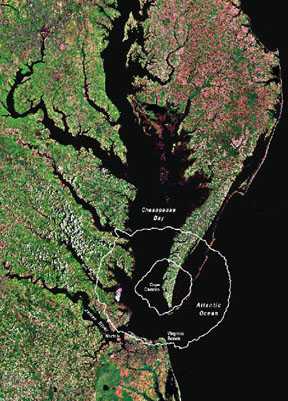geotimesheader
News
Notes
| Teaming
up to dig down
Thirty-five million years ago, huge chunks of space debris careened
into the eastern shore of what is now Virginia, gouging a crater 85 kilometers
wide and over one kilometer deep. The damage is still felt today in the
form of land subsidence and groundwater diversion. Now, scientists are
conducting the most detailed seismic survey and core sampling yet of the
Chesapeake Bay impact crater, including what some claim to be the first-ever
analyses of gases trapped within impact breccia.
Researchers from the U.S. Geological Survey (USGS), the Hampton Roads
Planning District Commission and Virginia have teamed up with colleagues
at NASA’s Langley Research Center to study the crater. Researchers hope
that the 2,700-foot core and seismic survey will uncover new structural
details of the crater, which is the largest in the United States.
The first evidence for the impact structure was uncovered outside the
crater in 1983, when C. Wylie Poag of the USGS was conducting research
aboard the NSF research vessel Glomar Challenger. On that voyage,
shipboard sedimentologists found tektites and shocked quartz in ejecta
from a drill core taken 120 kilometers east of Atlantic City, N.J. |

Mosaic of Landsat satellite
imagery acquired from 1990-94
shows the location of
the Chesapeake Bay impact crater,
with two lines representing
the inner and outer rims. USGS. |
Later studies by Poag, David Powars, also of USGS, and T. Scott Bruce
of the Virginia Department of Environmental Quality revealed that the rock
fragments were made of bits and pieces of sedimentary beds from southeast
Virginia. Coupled with seismic profiles provided by Texaco and Exxon in
1993, the evidence convinced the researchers that an impact structure lay
beneath the southern stretch of the Chesapeake Bay.
The researchers chose NASA’s Langley Research Center in Hampton, Va.,
as the coring site in part because it lies on the crater’s rim. “We have
the materials facility to take these cores, crush them under very good
vacuum conditions, and watch the gases that diffuse out,” says Joel Levine,
a senior research scientist at NASA-Langley. “That’s something that hasn’t
been done before.”
Levine was working as chief scientist on a project to send a small surveying
airplane to Mars when Virginia coastal geology expert Gerald Johnson of
the College of William and Mary called and suggested that NASA and USGS
team up. As a result of the recent Mars lander mishaps, NASA canceled Levine’s
airplane project, leaving him free to work on the Chesapeake Bay impact
crater. “Ironically,” Levine says, “one of the things we were going to
photograph [on Mars] was impact craters.”
Drilling began on July 23, and within weeks the Langley-USGS team had
reached more than 750 feet below the surface. The researchers cored across
a compaction fault lying over the buried crater and then hit the impact
breccia near the crater rim.
Researchers from around the nation are signing on to help with analyses.
According to Powars, the crater modeling will be done by one of the world’s
experts on impact dynamics, Jay Melosh of the University of Arizona Lunar
and Planetary Lab. Glenn Izett, research associate at William and Mary
and an expert on impact mineralogy and structures, has also joined the
team.
The seismic profiling will begin in September, and the data will have
a resolution down to five meters. “We’re getting into uncored territory,”Powars
says.
Josh Chamot
Geotimes contributing writer

